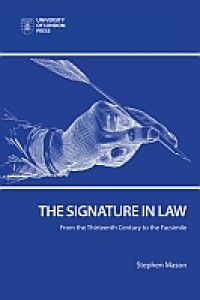
Text
E-Book The Signature in Law: From the Thirteenth Century to the Facsimile
Penilaian
0,0
dari 5
This book explores the judicial development of the concept of the signature from the thirteenth century to the age of the facsimile transmission. It puts the concept of the signature into a broad legal context to set out the purposes that can be attributed to a signature, and to explain the functions a signature is capable of performing. Drawing on cases from common law jurisdictions across the world, the book demonstrates that judges expanded the meaning of a signature as technologies developed and were used in unanticipated ways. Following an overview of the methods used to demonstrate proof of intent and authentication, the book considers the judicial response to the array of variations in the form that manuscript signatures have been subject over the past two hundred years, from initials, partial signatures and fingerprints, to rubber stamps and typewriting. Past judicial decision-making not only demonstrates the flexibility of the form a signature can take, but also confirms that judges had the flexibility of mind to accept the first forms of electronic signature (telex, facsimile transmission) as merely one further development without the aid of special legislation.
Ketersediaan
Informasi Detail
- Judul Seri
-
-
- No. Panggil
-
342 MAS t
- Penerbit
- London : University of London Press., 2022
- Deskripsi Fisik
-
122 halaman
- Bahasa
-
English
- ISBN/ISSN
-
9781911507321
- Klasifikasi
-
342
- Tipe Isi
-
text
- Tipe Media
-
computer
- Tipe Pembawa
-
online resource
- Edisi
-
-
- Subjek
- Info Detail Spesifik
-
-
- Pernyataan Tanggungjawab
-
Mason, Stephen
Versi lain/terkait
Tidak tersedia versi lain
Lampiran Berkas
Komentar
Anda harus masuk sebelum memberikan komentar
 Karya Umum
Karya Umum  Filsafat
Filsafat  Agama
Agama  Ilmu-ilmu Sosial
Ilmu-ilmu Sosial  Bahasa
Bahasa  Ilmu-ilmu Murni
Ilmu-ilmu Murni  Ilmu-ilmu Terapan
Ilmu-ilmu Terapan  Kesenian, Hiburan, dan Olahraga
Kesenian, Hiburan, dan Olahraga  Kesusastraan
Kesusastraan  Geografi dan Sejarah
Geografi dan Sejarah